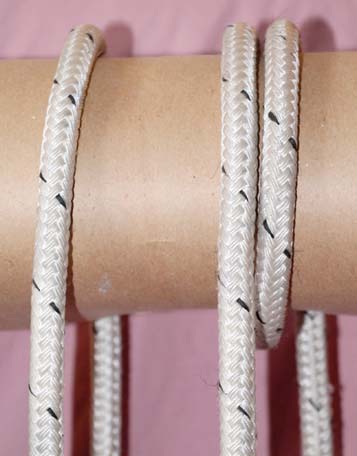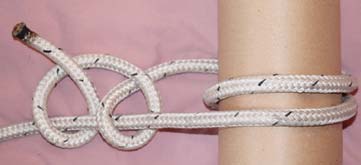Essential Knots Every Boater Should Master.
By Mark King

While there are many knots that boaters can use and many more that can be demonstrated, there are a few that all boaters should know that are handy for everyday use. From the bowline, which is often called “the king of knots” because in a pinch it can be used in almost every circumstance, to the well-known reef knot, there are five types of knots that boaters will find useful.
They are types of knots based on their use as there are three knots – including the Reef Knot – that can be used to tie two different diameter lines together and one knot that uses two names, based on its purpose.
But first, some illustrated definitions of a Crossing Turn, Bight, and Loop in one photograph and a Turn, and a Round Turn in the second. Note that the Round Turn makes one-and-a-half circles.
 Bowline
Bowline
As mentioned this is often called the king of knots because it can be useful in almost every circumstance. It is used to form a loop in a line. This knot won’t slip, jam or strain under pressure and is easily broken when it is time to release. Two bowlines can be used to join two pieces of line together. It cannot be broken while it is under strain.
 Cleat Hitch
Cleat Hitch
As its name suggests, it is used to tie a boat to a cleat. It is a simple knot consisting of two or more figure eights around the cleat horns to take the strain and then secured on the final pass. Always start around the horn which is farthest from the direction of the line.
Round Turn and Two Half Hitches or Anchor Bend
This knot consists of a round turn through an eye or around a post and two half hitches around the line. It is used to tie a boat to a mooring post or ring. The two turns around the post take the strain while you tie the hitches on the line.
As its second name says, it is also the knot used to tie the anchor rode to the anchor. When used as an anchor bend the end of the line should be whipped to the standing part.
 Clove Hitch
Clove Hitch
This knot has one practical purpose on board a boat and that is to initially tie fenders to the correct height while you are docking a boat at an unfamiliar location. An easy knot to make, it consists of two loops joined to form a knot. It has two faults. First, it can slip when loose so it should never be used as a final knot and should not be left unattended. The second fault is that, on the other hand, it can also bind once strained.
 Sheet Bend and Double Sheet Bend
Sheet Bend and Double Sheet Bend
This is the best knot to use to join two lines. If they are unequal diameter the larger diameter line forms the loop while the smaller diameter line forms the knot. If the lines are significantly different in diameter use a Double Sheet Bend for extra security. To make a Double Sheet Bend form the knot one more time.
 Reef Knot
Reef Knot
Often called a Figure Eight Knot and a Square Knot, it too can be used to join lines of unequal diameter. This knot has problems. It slips, it jams, and if not tied correctly ends up being a “Granny Knot” that slips more easily.
Learning these knots will be enough to keep you and your boat safe. If you are having difficulty understanding them there are many resources available at nautical book stores and on the internet that can help you learn how to tie them.


 Bowline
Bowline Cleat Hitch
Cleat Hitch

 Clove Hitch
Clove Hitch Sheet Bend and Double Sheet Bend
Sheet Bend and Double Sheet Bend Reef Knot
Reef Knot